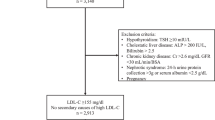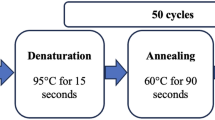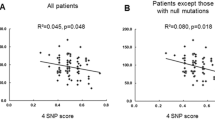Abstract
The LDL receptor has an essential role in regulating plasma LDL-C levels. Genetic variation in the LDLR gene can be associated with either lower or moderately raised plasma levels of LDL-C, or may cause familial hypercholesterolemia. The prevalence of single-nucleotide polymorphisms (SNPs) in the LDLR in the black South African population is not known and therefore, we aimed to determine the genotypic variation of the LDLR in the study population as well as to define the association of the different genotypes with plasma LDL-C levels. A random selection of 1860 apparently healthy black South African volunteers aged 35–60 years was made in a cross-sectional study. Novel SNPs were identified in a subset of 30 individuals by means of automated sequencing before screening the entire cohort by means of the Illumina VeraCode GoldenGate Genotyping Assay on a BeadXpress Reader system. Twenty-five SNPs were genotyped, two of which were novel. A very rare SNP, rs17249141, in the promoter region was significantly associated with lower levels of LDL-C. Four other SNPs (rs2738447, rs14158, rs2738465 and rs3180023) were significantly associated with increased levels of LDL-C. We can conclude that some of the various SNPs identified do indeed associate with LDL-C levels.
Similar content being viewed by others
Log in or create a free account to read this content
Gain free access to this article, as well as selected content from this journal and more on nature.com
or
References
Brown, M. S., Kovanen, P. T. & Goldstein, J. L. Regulation of plasma cholesterol by lipoprotein receptors. Science 212, 628–635 (1981).
Burnett, J. R. & Hooper, A. J. Common and rare gene variants affecting plasma LDL cholesterol. Clin. Biochem. Rev. 29, 11–26 (2008).
Steyn, K., Jooste, P. L., Bourne, L., Fourie, J., Badenhorst, C. J., Bourne, D. E. et al. Risk factors for coronary heart disease in the black population of the Cape Peninsula. The BRISK study. S. Afr. Med. J. 79, 480–485 (1991).
Walker, A. R. P. & Sareli, P. Coronary heart disease: outlook for Africa. J. R. Sc. Med. 90, 23–27 (1997).
Heller, D. A., de Faire, U., Pedersen, N. L., Dahlen, G. & McClearn, G. E. Genetic and environmental influences on serum lipid levels in twins. N. Engl. J. Med. 328, 1150–1156 (1993).
Soutar, A. K. & Naoumova, R. P. Mechanisms of disease: genetic causes of familial hypercholesterolemia. Nat. Clin. Pract. Card. 4, 214–225 (2007).
Scholtz, C., Peeters, A., Hoogendijk, C., Thiart, R., Villiers, J., Hillermann, R. et al. Mutation -59c->t in repeat 2 of the LDL receptor promoter: reduction in transcriptional activity and possible allelic interaction in a South African family with familial hypercholesterolaemia. Hum. Mol. Genet. 8, 2025–2030 (1999).
Teo, K., Chow, C. K., Vaz, M., Rangarajan, S. & Yusuf, S., PURE Investigators-Writing Group The Prospective Urban Rural Epidemiology (PURE) study: examining the impact of societal influences on chronic non-communicable diseases in low-, middle-, and high-income countries. Am. Heart. J. 158, 1–7 e1 (2009).
Friedewald, W. T., Levy, R. I. & Fredrickson, D. S. Estimation of the concentration of low-density lipoprotein cholesterol in plasma, without use of the preparative ultracentrifuge. Clin. Chem. 18, 499–502 (1972).
Collins, J. S. & Schwartz, C. E. Detecting polymorphisms and mutations in candidate genes. Am. J. Hum. Genet. 71, 1251 (2002).
Sanger, F., Nicklen, S. & Coulson, A. R. DNA sequencing with chain-terminating inhibitors. Proc. Natl Acad. Sci. USA 74, 5463–5467 (1977).
Lohman, T. G., Roche, A. F. & Martorell, R. Anthropometric Standardization Reference Manual 1st edn (Human kinetic books: Champaign, Illinois, 1988).
MacIntyre, U., Venter, C. & Vorster, H. A culture-sensitive quantitative food frequency questionnaire used in an African population: 1. Development and reproducibility. Public Health Nutr. 4, 53 (2001).
MacIntyre, U., Venter, C. & Vorster, H. A culture-sensitive quantitative food frequency questionnaire used in an African population: 2. Relative validation by 7-day weighed records and biomarkers. Public Health Nutr. 4, 63 (2001).
Langenhoven, M., Kruger, M., Gouws, E. & Faber, M. Medical Research Council Food Composition Tables (1998).
Soutar, A. K. in Low-density Lipoprotein Receptors eds Betteridge D. J., Illingworth D. R., Shepherd J., 303–322 (Arnold Publishers: London, 1999).
Cenarro, A., Jensen, H. K., Casao, E., Civeira, F., González–Bonillo, J., Rodríguez–Rey, J. C. et al. Identification of recurrent and novel mutations in the LDL receptor gene in Spanish patients with familial hypercholesterolemia. Hum. Mutat. 11, 413–413 (1998).
Pereira, E., Ferreira, R., Hermelin, B., Thomas, G., Bernard, C., Bertrand, V. et al. Recurrent and novel LDL receptor gene mutations causing heterozygous familial hypercholesterolemia in La Habana. Hum. Genet. 96, 319–322 (1995).
Ekström, U., Abrahamson, M., Sveger, T., Lombardi, P. & Nilsson-Ehle, P. An efficient screening procedure detecting six novel mutations in the LDL receptor gene in Swedish children with hypercholesterolemia. Hum. Genet. 96, 147–150 (1995).
Lu, Y., Feskens, E. J., Boer, J., Imholz, S., Verschuren, W., Wijmenga, C. et al. Exploring genetic determinants of plasma total cholesterol levels and their predictive value in a longitudinal study. Atherosclerosis 213, 200–205 (2010).
Amsellem, S., Briffaut, D., Carrié, A., Rabès, J., Girardet, J., Fredenrich, A. et al. Intronic mutations outside of Alu-repeat-rich domains of the LDL receptor gene are a cause of familial hypercholesterolemia. Hum. Genet. 111, 501–510 (2002).
Humphries, S. E., Whittall, R. A., Hubbart, C. S., Maplebeck, S., Cooper, J. A., Soutar, A. et al. Genetic causes of familial hypercholesterolaemia in patients in the UK: relation to plasma lipid levels and coronary heart disease risk. J. Med. Genet. 43, 943–949 (2006).
Lelli, N., Garuti, R., Ghisellini, M., Tiozzo, R., Rolleri, M., Aimale, V. et al. Occurrence of multiple aberrantly spliced mRNAs of the LDL-receptor gene upon a donor splice site mutation that causes familial hypercholesterolemia (FHBenevento). J. Lipid Res. 36, 1315–1324 (1995).
Zakharova, F., Damgaard, D., Mandelshtam, M., Golubkov, V., Nissen, P., Nilsen, G. et al. Familial hypercholesterolemia in St-Petersburg: the known and novel mutations found in the low density lipoprotein receptor gene in Russia. BMC Med. Genet. 6, 6 (2005).
Desmet, F., Hamroun, D., Lalande, M., Collod-Béroud, G., Claustres, M. & Béroud, C. Human Splicing Finder: an online bioinformatics tool to predict splicing signals. Nucleic Acids Res. 37, e67–e67 (2009).
Rafiq, S., Ahmed, N., Soutar, A. & Qamar, R. The genetic characterization of familial hypercholesterolemia in Pakistan. J. Basic Appl. Sci. 7, 21–25 (2011).
Bansal, A., Vignal, C. & McGinnis, R. in Tools for Statistical Genetics 2nd edn ed Barnes M. R., 217–246 (Wiley: West Sussex, England, 2008).
Gabriel, S. B., Schaffner, S. F., Nguyen, H., Moore, J. M., Roy, J., Blumenstiel, B. et al. The structure of haplotype blocks in the human genome. Science 296, 2225–2229 (2002).
Reich, D. E., Cargill, M., Bolk, S., Ireland, J., Sabeti, P. C., Richter, D. J. et al. Linkage disequilibrium in the human genome. Nature 411, 199–204 (2001).
Chen, J., Férec, C. & Cooper, D. N. A systematic analysis of disease-associated variants in the 3′ regulatory regions of human protein-coding genes I: general principles and overview. Hum. Genet. 120, 1–21 (2006).
Nakahara, M., Fujii, H., Maloney, P. R., Shimizu, M. & Sato, R. Bile acids enhance low density lipoprotein receptor gene expression via a MAPK cascade-mediated stabilization of mRNA. J. Biol. Chem. 277, 37229–37234 (2002).
Wilson, G., Vasa, M. & Deeley, R. Stabilization and cytoskeletal-association of LDL receptor mRNA are mediated by distinct domains in its 3′ untranslated region. J. Lipid Res. 39, 1025–1032 (1998).
Knouff, C., Malloy, S., Wilder, J., Altenburg, M. K. & Maeda, N. Doubling expression of the low density lipoprotein receptor by truncation of the 3′-untranslated region sequence ameliorates type iii hyperlipoproteinemia in mice expressing the human apoe2 isoform. J. Biol. Chem. 276, 3856–3862 (2001).
Muallem, H., North, K. E., Kakoki, M., Wojczynski, M. K., Li, X., Grove, M. et al. Quantitative effects of common genetic variations in the 3′ UTR of the human LDL-receptor gene and their associations with plasma lipid levels in the Atherosclerosis Risk in Communities study. Hum. Genet. 121, 421–431 (2007).
Linsel-Nitschke, P., Götz, A., Erdmann, J., Braenne, I., Braund, P., Hengstenberg, C. et al. Lifelong reduction of LDL-cholesterol related to a common variant in the LDL-receptor gene decreases the risk of coronary artery disease—A Mendelian Randomisation Study. PLoS One 3, 1–9 (2008).
Gudnason, V., Patel, D., Sun, X., Humphries, S., Soutar, A. & Knight, B. Effect of the StuI polymorphism in the LDL receptor gene (Ala 370 to Thr) on lipid levels in healthy individuals. Clin. Genet. 47, 68–74 (1995).
Vieira, J. R. S., Whittall, R. A., Cooper, J. A., Miller, G. J. & Humphries, S. E. The A370T variant (StuI polymorphism) in the LDL receptor gene is not associated with plasma lipid levels or cardiovascular risk in UK men. Ann. Hum. Genet. 70, 697–704 (2006).
El Messal, M., Chihab, K. A., Chater, R., Vallvé, J. C., Bennis, F., Hafidi, A. et al. Familial hypercholesterolemia in Morocco: first report of mutations in the LDL receptor gene. J. Hum. Genet. 48, 199–203 (2003).
Varret, M., Rabés, J., Thiart, R., Kotze, M. J., Baron, H., Cenarro, A. et al. LDLR Database: new additions to the database and the software, and results of the first molecular analysis. Nucleic Acids Res. 26, 248–252 (1998).
Acknowledgements
We thank the organizers of the South African PURE study, especially Prof A Kruger and her team, for providing the opportunity to work with the data and samples from the study population. This study would not have been possible without their contributions. Wayne Towers is thanked for his support with regard to the genetic aspects of the study as well as for obtaining funding for the project. Funding was received from the NorthWest University, and we would like to thank the institution for all of its contributions.
Author information
Authors and Affiliations
Corresponding author
Additional information
Supplementary Information accompanies the paper on Journal of Human Genetics website
Rights and permissions
About this article
Cite this article
van Zyl, T., Jerling, J., Conradie, K. et al. Common and rare single nucleotide polymorphisms in the LDLR gene are present in a black South African population and associate with low-density lipoprotein cholesterol levels. J Hum Genet 59, 88–94 (2014). https://doi.org/10.1038/jhg.2013.123
Received:
Revised:
Accepted:
Published:
Issue date:
DOI: https://doi.org/10.1038/jhg.2013.123



